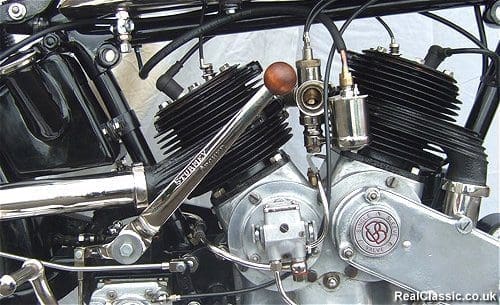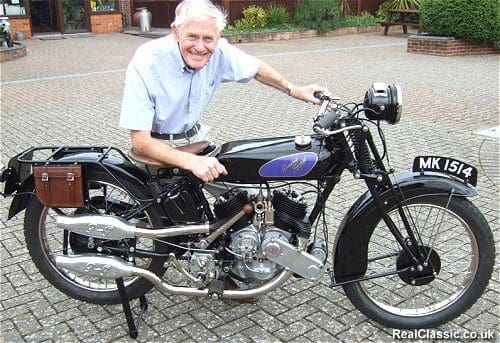Some vintage motorcycles become rare simply as a function of age – 80 or 90 years after they were built there simply aren’t many survivors so the ones which are left collect a certain kudos. But other old bikes feature fascinating engineering which made them interesting in their own right when they were new. Surviving into another century makes them real rarities.
One such motorcycle is the Grindlay-Peerless you see here. It’s been restored by the Sammy Miller Museum workshop and can be seen on display at the Museum in the south of England. Grindlay-Peerless built superb sidecars back in the 1920s and entered the motorcycle market itself in 1923 with a flagship model that put most other manufacturers in the shade. Just look at the twin silencers with their stylish monogram; the gleaming fuel tank and blaze of cadmium and nickel plate, and the leather-covered saddle. Even changing gear would be a tactile delight…
Ideally matched to the firm’s sidecars, the early Grindlay-Peerless motorcycles were well finished, substantial touring machines which used a 999cc V-Twin engine built by Barr and Stroud. And this is the really interesting bit – the technology which truly sets the Grindlay-Peerless apart from the other machines of its era.
 Barr and Stroud built sleeve-valve motors, a type of four-stroke engine which was popular in the 1920s and frequently used to power early aircraft. If you look at the photos of the motor you’ll notice a distinct lack of pushrods, valve springs, rockers or cams. The valve operation system allowed the spark plug to be best positioned for maximum efficiency, and needed far less maintenance than a traditional side-valve engine (remember that you’d be grinding in new valves every 20,000 miles or so back then).
Barr and Stroud built sleeve-valve motors, a type of four-stroke engine which was popular in the 1920s and frequently used to power early aircraft. If you look at the photos of the motor you’ll notice a distinct lack of pushrods, valve springs, rockers or cams. The valve operation system allowed the spark plug to be best positioned for maximum efficiency, and needed far less maintenance than a traditional side-valve engine (remember that you’d be grinding in new valves every 20,000 miles or so back then).
Some sleeve-valve engines suffered from very high oil consumption, but the Barr and Stroud motor employed a single-sleeve design by Burt-McCullum which overcame this problem (you can read more about the concept and its flaws here. Although the sleeve-valve concept wasn’t pursued in the long run by the automotive industry, the engines proved to be rugged and torquey with a good spread of power through to high revs, and this made them ideal for motorcycles in the 1920s.
Grindlay-Peerless added a 499cc sleeve-valve single to their range in 1925, and then a 348cc version joined the range alongside several other conventional, JAP-engined models. The JAP engines would have been more economical for Grindlay-Peerless to purchase, and the firm started to set records at Brooklands with Bill Lacey’s tuned JAP-powered bikes. Thus the sleeve-valve designs fell from favour and went out of production in 1927.
So the model you see here was built for just four years and it would have been one of the more expensive machines on the market at the time. The sleeve-valve engine drove a three-speed Sturmey Archer gearbox and drive was transmitted to the rear wheel by chain. The bike was, according to Ken Hallworth, ‘a fine sight, especially when coupled to one of their own sidecars.’
 Sammy Miller rode this very machine in the 60th anniversary Banbury Run, and it now takes pride of place in his museum, alongside a 500 sleeve-valve Grindlay-Peerless. ‘This bike is a real classic’ says the Museum’s manager; ‘and Sammy has never seen another like it on all his world travels. This is the only one that we know of.’
Sammy Miller rode this very machine in the 60th anniversary Banbury Run, and it now takes pride of place in his museum, alongside a 500 sleeve-valve Grindlay-Peerless. ‘This bike is a real classic’ says the Museum’s manager; ‘and Sammy has never seen another like it on all his world travels. This is the only one that we know of.’
Grindlay-Peerless continued building motorcycles with JAP, Villiers and Rudge engines (Grindlay Peerless were based just down the road from the Rudge factory) into the 1930s but moved out of motorcycle production in the mid-30s. However, at least one example of their most extraordinary model still exists today.
Classic and British bikes like this one appear every month in the pages of RealClassic magazine. Our in-depth articles by expert and enthusiast authors reflect the old bikes we buy and ride in the real world: frequently fabulous; occasionally awful, but always interesting…



